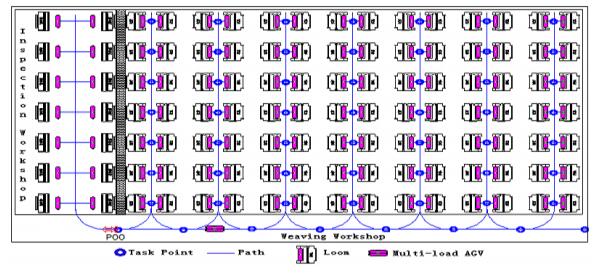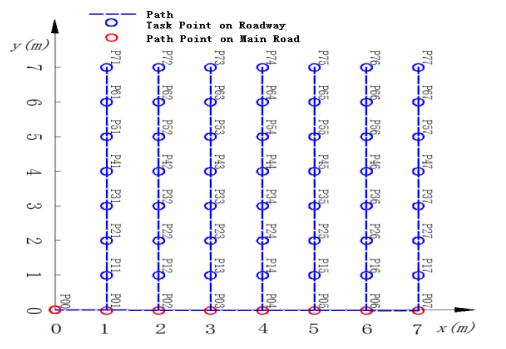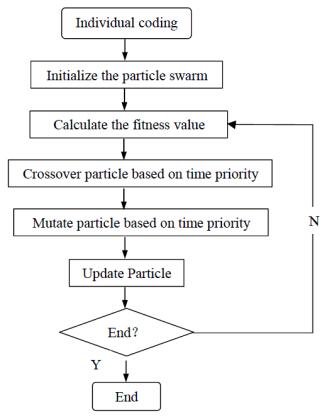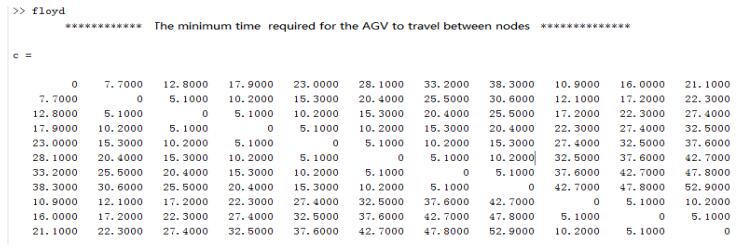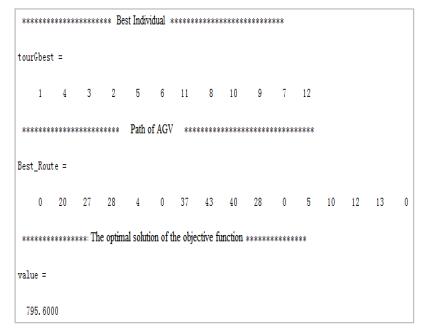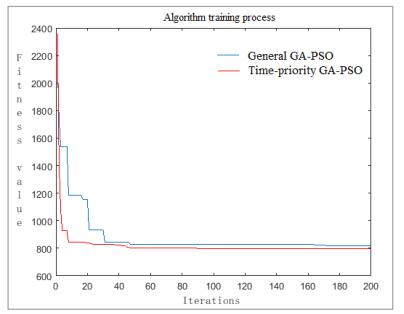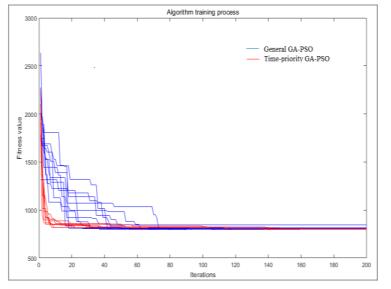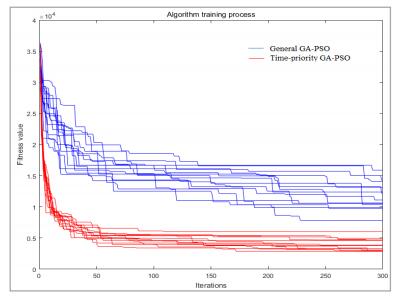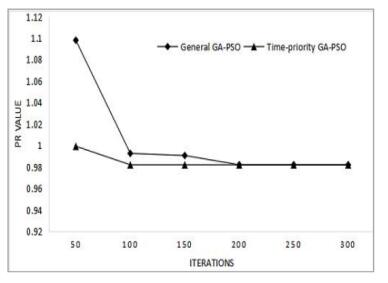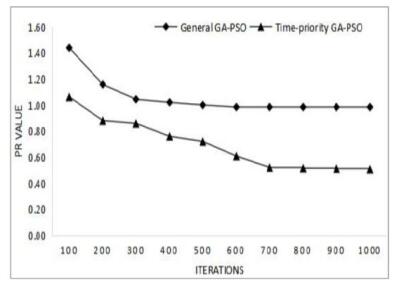The multi-load AGV (Automatic Guided Vehicle) is a new kind of materials handling equipment used to load cloth automatically in an intelligent weaving workshop. It can transport multiple rolls of cloth and choose the correct, most effective path to improve the transportation efficiency without people engaged in. This paper creates a feasible path topology according to the layout of the workshop and the logistics environment, and uses the Warshall-Floyd algorithm to search for the optimal route between two arbitrary points. The aim of the path planning is to maximize the machine efficiency, which is constrained by environmental limits, load limits and work limits. This paper establishes the mathematical model of the path planning problem using the mixed genetic particle swarm optimization algorithm (GA-PSO) to solve the problem, and the particle iteration mechanism based on the time priority is proposed to make the evolution more directional and accelerate the convergence speed of the algorithm. The effectiveness and practicability of the model and methods are verified by simulation and benefit analysis.
1.
Introduction
Mathematical models of physics, chemistry, ecology, physiology, psychology, engineering and social sciences have been governed by differential equation and difference equation. With the development of computers, compared with continuous-time model, discrete-time models described by difference equations are better formulated and analyzed in the past decades. Recently laser model has vast application in medical sciences, industries, highly security areas in army [1,2,3,4,5,6,7]. Laser, whose basic principal lies on the Einstein theory of light proposed in 1916, is a device that produces intense beam of monochromatic and coherent light. Since then it is developed by Gordon Gould in 1957. In 1960, the first working ruby laser was invented by Theodore Maiman. Laser light is coherent, highly directional and monochromatic which makes it different from ordinary light. The working principle of laser is based on the spontaneous absorption, spontaneous emission, stimulated emission, and population inversion are essential for the laser formation. The readers can refer to [8,9,10]. For instance, Hakin [11] proposed a simple continuous-time laser model in 1983. Khan and Sharif [12] proposed a discrete-time laser model and studied extensively dynamical properties about fixed points, the existence of prime period and periodic points, and transcritical bifurcation of a one-dimensional discrete-time laser model in R+.
In fact, the identification of the parameters of the model is usually based on statistical method, starting from data experimentally obtained and on the choice of some method adapted to the identification. These models, even the classic deterministic approach, are subjected to inaccuracies (fuzzy uncertainty) that can be caused by the nature of the state variables, by parameters as coefficients of the model and by initial conditions. In fact, fuzzy difference equation is generation of difference equation whose parameters or the initial values are fuzzy numbers, and its solutions are sequences of fuzzy numbers. It has been used to model a dynamical systems under possibility uncertainty. Due to the applicability of fuzzy difference equation for the analysis of phenomena where imprecision is inherent, this class of difference equation is a very important topic from theoretical point of view and also its applications. Recently there has been an increasing interest in the study of fuzzy difference equations (see [13,14,15,16,17,18,19,20,21,22,23,24,25]).
In this paper, by virtue of the theory of fuzzy sets, we consider the following discrete-time laser model with fuzzy uncertainty parameters and initial conditions.
where xn is the number of laser photon at the nth time, A,B,C,H and the initial value x0 are positive fuzzy numbers.
The main aim of this work is to study the existence of positive solutions of discrete-time laser model (1.1). Furthermore, according to a generation of division (g-division) of fuzzy numbers, we derive some conditions so that every positive solution of discrete-time laser model (1.1) is bounded. Finally, under some conditions we prove that discrete-time laser model (1.1) has a fixed point 0 which is asymptotically stable, and a unique positive fixed point x.
2.
Preliminaries and definitions
Firstly, we give the following definitions and lemma needed in the sequel.
Definition 2.1.[26] u:R→[0,1] is said to be a fuzzy number if it satisfies conditions (i)–(iv) written below:
(i) u is normal, i. e., there exists an x∈R such that u(x)=1;
(ii) u is fuzzy convex, i. e., for all t∈[0,1] and x1,x2∈R such that
(iii) u is upper semicontinuous;
(iv) The support of u, suppu=¯⋃α∈(0,1][u]α=¯{x:u(x)>0} is compact.
For α∈(0,1], the α−cuts of fuzzy number u is [u]α={x∈R:u(x)≥α} and for α=0, the support of u is defined as suppu=[u]0=¯{x∈R|u(x)>0}.
A fuzzy number can also be described by a parametric form.
Definition 2.2. [26] A fuzzy number u in a parametric form is a pair (ul,ur) of functions ul,ur,0≤α≤1, which satisfies the following requirements:
(i) ul(α) is a bounded monotonic increasing left continuous function,
(ii) ur(α) is a bounded monotonic decreasing left continuous function,
(iii) ul(α)≤ur(α),0≤α≤1.
A crisp (real) number x is simply represented by (ul(α),ur(α))=(x,x),0≤α≤1. The fuzzy number space {(ul(α),ur(α))} becomes a convex cone E1 which could be embedded isomorphically and isometrically into a Banach space (see [26]).
Definition 2.3.[26] The distance between two arbitrary fuzzy numbers u and v is defined as follows:
It is clear that (E1,D) is a complete metric space.
Definition 2.4.[26] Let u=(ul(α),ur(α)),v=(vl(α),vr(α))∈E1,0≤α≤1, and k∈R. Then
(i) u=v iff ul(α)=vl(α),ur(α)=vr(α),
(ii) u+v=(ul(α)+vl(α),ur(α)+vr(α)),
(iii) u−v=(ul(α)−vr(α),ur(α)−vl(α)),
(iv) ku={(kul(α),kur(α)),k≥0;(kur(α),kul(α)),k<0,
(v) uv=(min{ul(α)vl(α),ul(α)vr(α),ur(α)vl(α),ur(α)vr(α)},max{ul(α)vl(α),ul(α)vr(α),ur(α)vl(α),ur(α)vr(α)}).
Definition 2.5. [27] Suppose that u,v∈E1 have α-cuts [u]α=[ul,α,ur,α],[v]α=[vl,α,vr,α], with 0∉[v]α,∀α∈[0,1]. The generation of division (g-division) ÷g is the operation that calculates the fuzzy number s=u÷gv having level cuts [s]α=[sl,α,sr,α](here [u]α−1=[1/ur,α,1/ul,α]) defined by
provided that s is a proper fuzzy number sl,α is nondecreasing, sr,α is nonincreasing, sl,1≤sr,1.
Remark 2.1. According to [27], in this paper the fuzzy number is positive, if u÷gv=s∈E1 exists, then the following two cases are possible
Case I. if ul,αvr,α≤ur,αvl,α,∀α∈[0,1], then sl,α=ul,αvl,α,sr,α=ur,αvr,α,
Case II. if ul,αvr,α≥ur,αvl,α,∀α∈[0,1], then sl,α=ur,αvr,α,sr,α=ul,αvl,α.
Definition 2.6. [26] A triangular fuzzy number (TFN) denoted by A is defined as (a,b,c) where the membership function
The α−cuts of A=(a,b,c) are described by [A]α={x∈R:A(x)≥α}=[a+α(b−a),c−α(c−b)]=[Al,α,Ar,α], α∈[0,1], it is clear that [A]α are closed interval. A fuzzy number A is positive if suppA⊂(0,∞).
The following proposition is fundamental since it characterizes a fuzzy set through the α-levels.
Proposition 2.1.[26] If {Aα:α∈[0,1]} is a compact, convex and not empty subset family of Rn such that
(i) ¯⋃Aα⊂A0.
(ii) Aα2⊂Aα1 if α1≤α2.
(iii) Aα=⋂k≥1Aαk if αk↑α>0.
Then there is u∈En(En denotes n dimensional fuzzy number space) such that [u]α=Aα for all α∈(0,1] and [u]0=¯⋃0<α≤1Aα⊂A0.
The fuzzy analog of the boundedness and persistence (see [15,16]) is as follows:
Definition 2.7. A sequence of positive fuzzy numbers (xn) is persistence (resp. bounded) if there exists a positive real number M (resp. N) such that
A sequence of positive fuzzy numbers (xn) is bounded and persistence if there exist positive real numbers M,N>0 such that
A sequence of positive fuzzy numbers (xn),n=1,2,⋯, is an unbounded if the norm ‖xn‖,n=1,2,⋯, is an unbounded sequence.
Definition 2.8. xn is a positive solution of (1.1) if (xn) is a sequence of positive fuzzy numbers which satisfies (1.1). A positive fuzzy number x is called a positive equilibrium of (1.1) if
Let (xn) be a sequence of positive fuzzy numbers and x is a positive fuzzy number, xn→x as n→∞ if limn→∞D(xn,x)=0.
Lemma 2.1. [26] Let f:R+×R+×R+×R+→R+ be continuous, A,B,C,D are fuzzy numbers. Then
3.
Main results
3.1. Existence of positive solution of discrete-time laser model
Firstly we give the existence of positive solutions of discrete-time laser model with fuzzy environment.
Theorem 3.1. Let parameters A,B,C,H and initial value x0 of discrete-time laser model be fuzzy numbers. Then, for any positive fuzzy number x0, there exists a unique positive solution xn of discrete-time laser model with initial conditions x0.
Proof. The proof is similar to those of Proposition 2.1 [25]. So we omit the proof of Theorem 3.1.
Noting Remark 2.1, taking α-cuts, one of the following two cases holds
Case I
Case II
3.2. Dynamics of discrete-time laser model (1.1)
To study the dynamical behavior of the positive solutions of discrete-time laser model (1.1), according to Definition 2.5, we consider two cases.
First, if Case I holds true, we need the following lemma.
Lemma 3.1. Consider the following difference equation
where a∈(0,1),b,c,h∈(0,+∞),y0∈(0,+∞), then the following statements are true:
(i) Every positive solution of (3.3) satisfies
(ii) The equation has a fixed point y∗=0 if b≤(1−a)h.
(iii) The equation has two fixed points y∗=0,y∗=bc(1−a)−hc if b>(1−a)h.
Proof. (i) Let yn be a positive solution of (3.3). It follows from (3.3) that, for n≥0,
From which we have
This completes the proof of (i).
If y∗ is fixed point of (3.3), i.e., yn=y∗. So from (3.3), we have
After some manipulation, from (3.5), we can get
From (3.3), we can summarized the existence of fixed points as follows
(ii) If b<h(1−a), then y∗=bc(1−a)−hc is not a positive number. And hence if b≤h(1−a) then (3.3) has a fixed point y∗=0.
(iii) If b>h(1−a), then y∗=bc(1−a)−hc is a positive number. And hence if b>h(1−a) then (3.3) has two fixed points y∗=0,y∗=bc(1−a)−hc.
Proposition 3.1. The following statements hold true
(i) The fixed point y∗=0 of (3.3) is stable if b<(1−a)h.
(ii) The fixed point y∗=0 of (3.3) is unstable if b>(1−a)h.
(iii) The fixed point y∗=0 of (3.3) is non-hyperbolic if b=(1−a)h.
Proof. From (3.3), let
From (3.7), it follows that
From (3.8), it can get
Therefore from (3.9), it can conclude that y∗=0 is stable if b<(1−a)h, unstable if b>(1−a)h, non-hyperbolic if b=(1−a)h.
Proposition 3.2. The fixed point y∗=bc(1−a)−hc of (3.3) is globally asymptotically stable if b>(1−a)h.
Proof. From (3.8), it can get
Therefore from (3.10), it can conclude that, if a+h(1−a)2b<1, i.e., b>(1−a)h then the fixed point y∗=bc(1−a)−hc is stable.
On the other hand, it follows from (3.4) that (yn) is bounded. And from (3.8), we have f′(y)>0. Namely (yn) is monotone increasing. So we have
Therefore the fixed point y∗=bc(1−a)−hc is globally asymptotically stable.
Proposition 3.3. The fixed point y∗=0 of (3.3) is globally asymptotically stable if b<(1−a)h.
Proof. From (3.3), we can get that
From (3.12), it follows that
Since b<(1−a)h, then limn→∞yn=0. Therefore the fixed point y∗=0 of (3.3) is globally asymptotically stable.
Theorem 3.2. Consider discrete-time laser model (1.1), where A,B,C,H and initial value x0 are positive fuzzy numbers. There exists positive number NA, ∀α∈(0,1], Ar,α<NA<1. If
and
Then (1.1) has a fixed point x∗=0 which is globally asymptotically stable.
Proof. Since A,B,C,H are positive fuzzy numbers and (3.14) holds true, taking α-cuts of model (1.1) on both sides, we can have the following difference equation system with parameters
Since (3.15) holds true, using Proposition 3.2, we can get
On the other hand, let xn=x∗, where [xn]α=[Ln,α,Rn,α]=[Lα,Rα]=[x∗]α,α∈(0,1], be the fixed point of (1.1). From (3.16), one can get
Since (3.15) is satisfied, from (3.16), it follows that
Therefore, by virtue of Proposition 3.3, the fixed point x∗=0 is globally asymptotically stable.
Theorem 3.3. Consider discrete-time laser model (1.1), where A,B,C,H and initial value x0 are positive fuzzy numbers, there exists positive number NA, ∀α∈(0,1], Ar,α<NA<1. If (3.14) holds true, and
then the following statements are true.
(i) Every positive solution of (1.1) is bounded.
(ii) Equation (1.1) has a unique positive fixed point x∗ which is asymptotically stable.
Proof. (i) Since A,B,C,H and x0 are positive fuzzy numbers, there exist positive constants MA,NA,MB, NB,MC,NC,MH,NH,M0,N0 such that
Using (i) of Lemma 3.1, we can get that
From (3.21) and (3.22), we have that for α∈(0,1]
where N=NBMC(1−NA)+N0. From (3.22), we have for n≥1,⋃α∈(0,1][Ln,α,Rn,α]⊂(0,N], so ¯⋃α∈(0,1][Ln,α,Rn,α]⊂(0,N]. Thus the proof of (i) is completed.
(ii) We consider system (3.18), then the positive solution of (3.18) is given by
Let xn be a positive solution of (1.1) such that [xn]α=[Ln,α,Rn,α],α∈(0,1],n=0,1,2,⋯. Then applying Proposition 3.2 to system (3.16), we have
From (3.23) and (3.25), we have, for 0<α1<α2<1,
Since Al,α,Ar,α,Bl,α,Br,α,Cl,α,Cr,α,Hl,α,Hr,α are left continuous. It follows from (3.24) that Lα,Rα are also left continuous.
From (3.21) and (3.24), it follows that
Therefore (3.27) implies that [Lα,Rα]⊂[c,d], and so ⋃α∈(0,1][Lα,Rα]⊂[c,d]. It is clear that
So from Definition 2.2, (3.24), (3.26), (3.28) and since Lα,Rα,α∈(0,1] determine a fuzzy number x∗ such that
Suppose that there exists another positive fixed point ˉx of (1.1), then there exist functions ¯Lα,¯Rα:(0,1)→(0,∞) such that
From which we have
So ¯Lα=Lα,¯Rα=Rα,α∈(0,1]. Hence ˉx=x∗, namely x∗ is a unique positive fixed point of (1.1).
From (3.25), we have
Namely, every positive solution xn of (1.1) converges the unique fixed point x∗ with respect to D as n→∞. Applying Proposition 3.2, it can obtain that the positive fixed point x∗ is globally asymptotically stable.
Secondly, if Case II holds true, it follows that for n∈{0,1,2,⋯},α∈(0,1]
We need the following lemma.
Lemma 3.2. Consider the system of difference equations
where ai∈(0,1),bi,ci,hi∈(0,+∞)(i=1,2),y0,z0∈(0,+∞). If
and
Then the following statements are true.
(i) Every positive solution (yn,zn) of (3.32) satisfy
(ii) System (3.32) has fixed point (y,z)=(0,0) which is asymptotically stable.
(iii) System (3.32) has a unique fixed point
where K=b1b2−h1h2(1−a1)(1−a2)(1−a1)(1−a2).
Proof. (i) Let (yn,zn) be a positive solution of (3.32). It follows from (3.32) that, for n≥0,
From which, we have
This completes the proof of (i).
(ii) It is clear that (0,0) is a fixed point of (3.32). We can obtain that the linearized system of (3.32) about the fixed point (0,0) is
where Xn=(xn,yn)T and
Thus the characteristic equation of (3.37) is
Since (3.33) and (3.34) hold true, we have
By virtue of Theorem 1.3.7 [28], we obtain that the fixed point (0,0) is asymptotically stable.
(iii) Let (yn,zn)=(y,z) be fixed point of (3.32). We consider the following system
It is clear that the positive fixed point (y,z) can be written by (3.36).
Theorem 3.4. Consider the difference Eq (1.1), where A,B,C,H are positive fuzzy numbers. There exists positive number NA,∀α∈(0,1],Ar,α<NA<1. If
and
Then the following statements are true
(i) Every positive solution of (1.1) is bounded.
(ii) The Eq (1.1) has a fixed point 0 which is globally asymptotically stable.
(iii) The Eq (1.1) has a unique positive fixed point x such that
where
Proof. (i) Let xn be a positive solution of (1.1). Applying (i) of Lemma 3.2, we have
Next, the proof is similar to (i) of Theorem 3.3. So we omit it.
(ii) The proof is similar to those of Theorem 3.2. We omit it.
(iii) Let xn=x be a fixed point of (1.1), then
Taking α-cuts on both sides of (3.46), since (3.41) holds true, one gets the following system
From which we obtain that
Next, we can show that Lα,Rα constitute a positive fuzzy number x such that [x]α=[Lα,Rα],α∈(0,1]. The proof is similar to (ii) of Theorem 3.3. We omit it.
Remark 3.1. In dynamical system model, the parameters of model derived from statistic data with vagueness or uncertainty. It corresponds to reality to use fuzzy parameters in dynamical system model. Compared with classic discrete time laser model, the solution of discrete time fuzzy laser model is within a range of value (approximate value), which are taken into account fuzzy uncertainties. Furthermore the global asymptotic behaviour of discrete time laser model are obtained in fuzzy context. The results obtained is generation of discrete time Beverton-Holt population model with fuzzy environment [25].
4.
Numerical simulations
In this section, we give two numerical examples to verify the effectiveness of theoretic results obtained.
Example 4.1. Consider the following fuzzy discrete time laser model
we take A,B,C,H and the initial values x0 such that
From (4.2), we get
From (4.3) and (4.4), we get
Therefore, it follows that
From (4.1), it results in a coupled system of difference equations with parameter α,
Therefore, it is clear that Ar,α<1,∀α∈(0,1], (3.14) and (3.15) hold true. so from Theorem 3.2, we have that every positive solution xn of Eq (4.1) is bounded In addition, from Theorem 3.2, Eq (4.1) has a fixed point 0. Moreover every positive solution xn of Eq (4.1) converges the fixed point 0 with respect to D as n→∞. (see Figures 1–3).
Example 4.2. Consider the following fuzzy discrete time laser model (4.1). where A,C,H and the initial values x0 are same as Example 4.1.
From (4.9), we get
Therefore, it follows that
It is clear that (3.20) is satisfied, so from Theorem 3.3, Eq (4.1) has a unique positive equilibrium ¯x=(0.341,1.667,3). Moreover every positive solution xn of Eq (4.1) converges the unique equilibrium ¯x with respect to D as n→∞. (see Figures 4–6)
5.
Conclusions
In this work, according to a generalization of division (g-division) of fuzzy number, we study the fuzzy discrete time laser model xn+1=Axn+BxnCxn+H. The existence of positive solution and qualitative behavior to (1.1) are investigated. The main results are as follows
(i) Under Case I, the positive solution is bounded if Bl,α<Hl,α(1−Al,α),Br,α<Hr,α(1−Ar,α),α∈(0,1]. Moreover system (1.1) has a fixed point 0 which is globally asymptotically stable. Otherwise, if Bl,α≥Hl,α(1−Al,α),Br,α≥Hr,α(1−Ar,α),α∈(0,1]. Then system (1.1) has a unique positive fixed point x∗ which is asymptotically stable.
(ii) Under Case II, if Al,α+Ar,α<1 and Bl,αBr,α>Hl,αHr,α(1−Al,α)(1−Ar,α),α∈(0,1], then the positive solution is bounded. Moreover system (1.1) has a unique positive fixed point x and fixed point 0 which is global asymptotically stable.
Acknowledgments
The authors would like to thank the Editor and the anonymous Reviewers for their helpful comments and valuable suggestions to improve the paper. The work is partially supported by National Natural Science Foundation of China (11761018), Scientific Research Foundation of Guizhou Provincial Department of Science and Technology([2020]1Y008, [2019]1051), Priority Projects of Science Foundation at Guizhou University of Finance and Economics (2018XZD02), and Scientific Climbing Programme of Xiamen University of Technology(XPDKQ20021).
Conflict of interest
The authors declare that they have no competing interests.
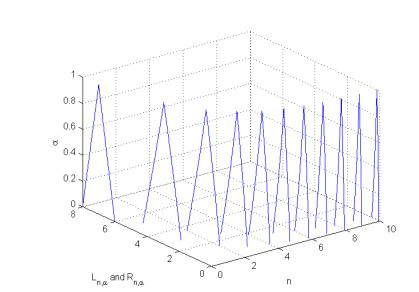









 DownLoad:
DownLoad:






